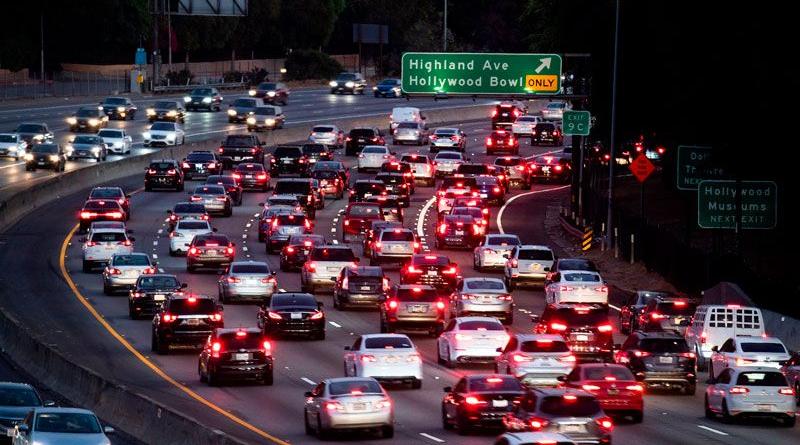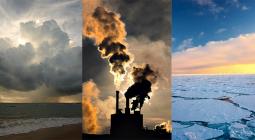Trump’s decision to block California vehicle emissions rules could have a wide impact.

Revoking the state’s tough fuel-efficiency standards would increase US greenhouse-gas emissions.
US President Donald Trump’s administration plans to revoke California’s legal authority to set its own automobile-emissions standards for cars and trucks. Trump announced the decision in a series of tweets on 18 September.
The move to end the decades-long arrangement deepens the administration’s feud with California’s liberal political leadership. It comes less than two months after four major automakers struck a deal with the state to abide by its fuel-efficiency rules for new vehicles rather than a looser federal standard proposed by the Environmental Protection Agency (EPA).
Nature examines the implications of the EPA’s move and how it could play out.
Why is the Trump administration doing this?
In a speech on 17 September, EPA administrator Andrew Wheeler said that creating a single national standard would prevent unnecessary fuel-efficiency upgrades that increase the price of cars ― and inadvertently keep older, more dangerous vehicles on the road.
“One national standard will provide much-needed regulatory certainty to auto makers, dealers, and consumers,” Wheeler told the National Automobile Dealers Association.
The decision furthers the administration’s push to weaken an array of regulations put in place by Trump’s predecessor, Barack Obama, that are designed to reduce greenhouse-gas emissions. In August, the EPA proposed freezing fuel-efficiency standards for automobiles in 2020, rather than increasing average fuel efficiency gradually to 2025. The agency has not yet finalized that plan.
Why does California have its own standard?
The state has long struggled to reduce smog in cities such as Los Angeles. The federal Clean Air Act, enacted in 1970, alludes to this. It grants California special status, allowing it to ask the EPA for permission to set pollution limits tougher than federal standards. To do so, California must prove it faces “compelling and extraordinary” circumstances.
The federal government has granted many of California’s requests to set its own air-pollution standards over the last four decades ― with rare exceptions. The current dispute centres on California’s ability to regulate greenhouse gas emissions from automobiles by increasing their fuel efficiency. The EPA denied the state’s request in 2007, during the administration of President George W. Bush.
California sued to reverse the decision. The legal fight ended in 2009, when then-president Barack Obama’s administration granted California’s request.
What’s the big deal? There are 49 other US states.
The Clean Air Act allows other states to adopt California’s standards as their own. Twelve other states, plus Washington DC, have chosen to abide by California’s fuel-efficiency standard.
The state’s influence grew last month when Ford Motor Company, Volkswagen of America, Honda and BMW pledged to adopt California’s standards if the Trump administration weakened federal limits. That agreement reflects automakers’ desire for clear rules of the road, so they can make investment decisions without being waylaid by sudden federal policy changes.
How will this affect US greenhouse-gas emissions?
The transportation sector produces about 29% of the United States’ greenhouse-gas output. Even small changes to the regulations governing auto emissions can have large effects on the country’s overall emissions.
By 2025, the Trump administration’s proposal to freeze fuel-efficiency standards would increase average greenhouse gas emissions from new vehicles by 20% compared to the level projected under the current rules, says John DeCicco, an engineer at the University of Michigan in Ann Arbor who tracks vehicle regulations.
By 2035, factoring in changes across the entire US vehicle fleet, the administration’s plan could increase overall oil consumption and greenhouse gas emissions by 6.5%.
Can California stop Trump?
Maybe. Within hours of Trump’s announcement, California leaders pledged to challenge the decision in court ― and spoke confidently about their odds.
“We will prevail,” Governor Gavin Newsom, a Democrat, said during a press conference on 18 September. Newsom dismissed the Trump administration’s claims that revoking California’s auto standard would promote public safety and public health. “It’s about the oil industry, period, full stop,” said the governor, who accused Trump of bowing to special interests.
Other states and environmental groups are likely to join in. Such a lawsuit could go all the way to the Supreme Court. The outcome could hinge on whether California can make the case that its greenhouse-gas regulations are the product of “compelling and extraordinary” circumstances, as defined by the Clean Air Act. That argument was easy to make when smog choked the air in Los Angeles. Now the state must prove that climate change represents a similar threat.
If California loses in court, the Trump administration would be able to set a single standard covering fuel efficiency and greenhouse gas emissions for all vehicles in the United States.
18 September 2019
Nature




